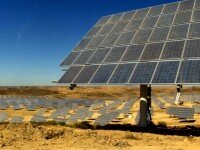Spanish energy policies
Posted in Policy on 08/21/2009 06:06 pm by Stephen Tindale Spain is a strong example of how government can shape the energy system in progressive ways.
Spain is a strong example of how government can shape the energy system in progressive ways.
Spain has a lot of coal, but needs to import oil and gas. Its share of the EU Kyoto target allows it to increase overall emissions by 40%. However, it has increased emissions, against 1990 levels, by over 50% (see Spain – climate and energy statistics). Therefore, the government recognises that it needs to do more to control emissions. In addition, the EU’s Large Combustion Plants Directive, which aims to control acid rain, will require about two-thirds of Spain’s existing coal stations to close by 2015.
The obvious answer to the climate and energy security issues facing the country is a massive expansion of renewables. The previous, centre-right government had already introduced policies to promote these. In 2004, Spain had 8.3Gw of installed wind capacity. In 2002, it had become the first country to introduce a Feed-in Tariff (FiT) for solar thermal technology to heat water (having had a FiT for renewable electricity since 1994). However, the Socialists were determined to go further and, in 2005, published the Renewable Energy Plan 2005-2010, which set a target that 30% of Spain’s electricity should be renewable by 2010 – with half of this coming from 20Gw of wind. More important than the target were the measures for delivery, including tax relief, low-interest loans and subsidies for investors. Four years into the five year plan, the 30% electricity target had already been passed – at the start of 2009, 35% of the country’s electricity was renewable. The wind target hasn’t yet been passed, but certainly looks reachable – Spain had 16.7Gw of wind at the end of 2008. Wind expansion is less problematic in Spain because there is less public opposition than there is in other countries. In Spain, about one application in five attracts significant public opposition – in the UK it is five in five!
Even more impressive than the wind expansion is the solar take-off. PV has increased from just 50Mw in 2005 to 3.3Gw at the end of 2008. This was partly due to high financial support. The Spanish FiT rate for solar was €0.41 to 0.44 per kilowatt hour (kWh). This was partly due to regulatory measures – in 2005, Spain became the first country in the world to require solar PV on all new buildings or significant refurbishments. (The Spanish government recognised that renewable energy doesn’t just mean renewable electricity. Spain was the second in the world, after Israel, to require solar thermal.)
This led to massive expansion. From 50Mw in 2005, solar PV grew to 700Mw in 2007 and 3.3Gw in 2008. Only 400Mw of the expansion was supposed to be supported by the FiT. Therefore, in autumn 2008, the government lowered the FiT rate – it is now €0.32 to 0.34 per kWh (the same as in Germany). A cap of 500Mw for 2009, for capacity to receive the FiT, was also announced. Spain’s solar trade associations said they were reasonably satisfied with this outcome, which was a higher rate and cap than the government had originally proposed (see Reuters: Spain ratifes new solar subsidy cap). Despite this, 2009 looks like being a much worse year for the Spanish solar industry than 2008 (see Datamonitor: Boom and bust for Spain’s heavily subsidized solar industry), because the reduced tariffs coincided with the Spanish economy being particularly hard hit by the global recession.
Spain is also moving to implement ambitious plans for Concentrated Solar Power (CSP). In 2007, the government announced that CSP plants up to 50 Mw would receive the same rate of FiT as PV receives, guaranteed for 25 years. And it announced that the first 200 Mw of CSP would receive a top-up tariff, which led developers to outline plans for twelve CSP plants, each 50 Mw. Many of these should be operational by the end of 2010.
Some regional governments are also actively promoting renewables. Galicia and Castile y Leon produced over 70% of their total electricity demand from renewables in 2006. Extramadura and Castile-La Mancha were fossil-fuel free in 2006, generating all their electricity from renewables and nuclear. However, the future of nuclear power in Spain is very unclear. About 60% of Spaniards say that they oppose nuclear power. The Socialist Government has said that it will not extend the life of Spain’s existing nuclear power stations. However, only one is due to close in the next decade and the government has said that it will not close this one until 2013 – which is after the next general election. The opposition party says that it would extend the plant’s life.

